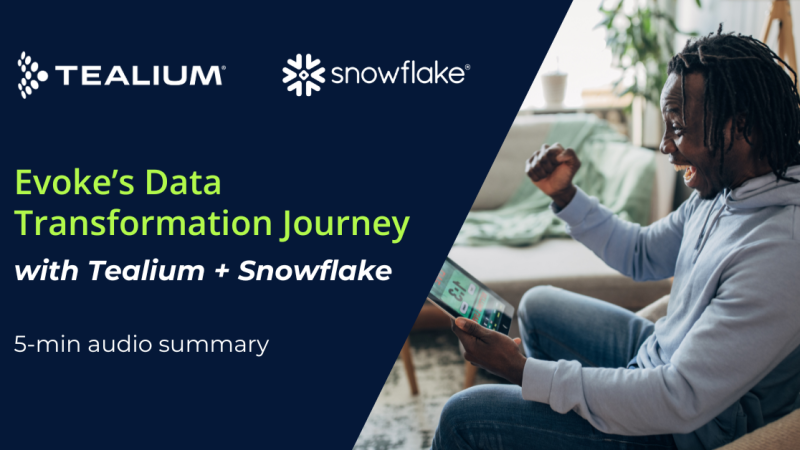The way your organization collects and activates customer interaction data has become one of the most significant factors in determining the quality of the customer experience you can deliver. Data-driven decision-making and real-time personalization are no longer competitive advantages; they are necessities for meeting customer expectations.
In light of (1) composable and AI technology trends, (2) customer expectations for CX convenience and speed, and (3) privacy and compliance requirements, data strategy has become a primary inflection point for creating differentiated CX value with efficiency and without risk. Customer-facing and technical teams should collaborate on a common data and technology core using a Customer Data Platform (CDP) and Cloud Data Warehouse (CDW) to best compete and differentiate in the market with data.

This blog covers part of the topics discussed in Tealium’s Era of Data Differentiation white paper. In this blog post, we’ll focus on the powerful Real-time Customer Data Platform (CDP) + Cloud Data Warehouse (CDW) combo. To read more about the CDP + CDW combination, you can also read Snowflake’s Modern Marketing Data Stack report (featuring Tealium!)here (or check out Tealium in the Snowflake Solution Center).
In that report, Snowflake delves into market trends demanding a rethink of your data foundation including Generative AI, Privacy, and Data Gravity, along with how complementing your cloud data warehouse with other technology creates a more powerful and agile modern data stack. Or read about how Tealium enables a composable tech architecture in this blog post.
Multiple Demands on Customer Data Foundation
To architect a suitable data stack solution for CX, it’s important to first recognize the multi-dimensional nature of the use cases for your customer data foundation. For the purposes of customer engagement, we can narrow in on four major applications of customer data: Identity and Personalization, Privacy and Compliance, Analytics and Insights, and AI. Across this diversity of demands, the CDP and CDW pairing offer many benefits.

Overview of “dual-zone” architecture of CDP + CDW
Each of these applications has unique requirements for your data and benefits from a “dual zone” data foundation for enterprise data, similar to how modern computers operate with RAM for speed and agility, and a Hard Drive for long-term, in-depth data storage.
- Identity and Personalization: Mapping data to an individual varies by channel, over time, and sometimes isn’t even required. This means instances where data needs to be assembled and delivered rapidly (maybe without identity resolution) and other instances where it’s more about storing historical insights. If all data must be stored prior to activation, this significantly limits in-the-moment customer experiences.
- Privacy and Compliance: Data that enters enterprise ecosystems comes with a cost. Not only the literal cost of managing the data (from processing it, to storing it, even to deleting it), but the risk costs associated with it. Again, this data must be recognized and managed immediately and long term to maximize value and limit risks.
- Analytics and Insights: Analytics similarly also has real-time and long term requirements for data. Many times analytics will require multiple phases of data cleansing, however these rounds cannot be accomplished at the speed of the customer, underscoring the spectrum of data capabilities required from a modern data foundation.
- AI: The value of AI also depends both on real-time (context) and historical data (customer understanding), with the common refrain “garbage in, garbage out” for data quality. Furthermore, compliance and cost considerations demand that this intelligent filtering of data happen immediately at the point of collection or else risk increases and AI processing costs can become prohibitively expensive.
Managing this range of use cases for customer data, across real-time and long-term applications, is prohibitively costly and time consuming on a technology-by-technology basis— even if data is centralized in a CDW at high enough quality to use efficiently (which is usually not the case).
This was well captured at Digital Velocity 2024 by Mark Loovis, Sr Director of Martech at DIRECTV, who stated, “We have several use cases where we were able to do something in minutes that in an old architecture took us days and took 5 FTEs [full-time employees] all day for a whole week to get done. That’s huge.” And according to a report by Economist Intelligence unit, “3-12 months is the average backlog for planned IT projects, and the situation is worsening as business project demand outstrips IT budget growth.” A central, accessible, and nimble system can help.
A real-time CDP and a data layer can pair with CDWs to better personalize CX, increase operational efficiency by leveraging data for campaigns, improve agility, and reduce compliance risk.
Take a Data Layer Approach with a Real-Time CDP
The diversity of use cases detailed above requires a data foundation that can achieve:
- Management of data from both anonymous and known visitors (and all the shades in between, not to mention transitioning between them)
- Evaluation and control of data at the point of collection— for identity, value, quality, insights, etc. It’s important this control is at the point of data capture because any data that enters the organization’s ecosystem incurs cost and risk to manage. Yet, it may have value to inform an ongoing interaction and you want to harvest this value without risk.
- Interoperability and agility between data venues and types at high speed; including data managed in the cloud (such as through APIs) and on devices (such as 1st and 3rd party cookies), and also event-level (like pageviews and clicks) and person-level data (such as identifiers and customer attributes)
- Long-term, unlimited storage and analysis power
- Automation to handle volumes beyond human capacity
- Enable collaboration across the organization for aligning business goals and technical requirements
This requires two systems with two different sets of capabilities and scopes, managed separately but in conjunction with each other— A deep and long-term storage solution with unlimited analysis horsepower, and a quick and nimble system that can evaluate and filter fast.
Being data driven though, starts at the data layer, irrespective of technology. To build a foundation meeting these requirements means taking a data layer approach that starts outside the technology, but ultimately flows into and between them. The data layer is a specification for the customer interaction tracking that flows from all your customer touchpoints including desktop and mobile website visits, mobile apps, connected devices, contact centers, and offline sources. It standardizes inbound data capture into common terminology and formats for your company that can be consented to, monitored, and audited. This approach produces massive downstream benefits.
The data layer must:
- Be defined ahead of time— this is critical to enable real-time data processing and delivery, enable filtering of data for cost or compliance
- Be defined in the business’ own terms, not a vendor schema
- Be human and AI readable, not in abstract variables
- Include consent context even if data is event or person-level
- Come with enforcement and tools to transform and enrich at the point of evaluation
Taking a data layer approach and combining a real-time CDP with your CDW ultimately means you get an agile, secure, and performant engine for your CX that drives differentiation through your own view of the customer.
More Reading

Read more about the powerful CDW + CDP combination, and other insights into how you can use your data foundation as a differentiator, in Tealium’s new white paper, The Era of Data Differentiation.
Also, check out Snowflake’s Modern Marketing Data Stack report for a more holistic look at how other technologies complement the Snowflake Data Cloud.
See how Tealium and Snowflake work better together by checking out:
- Snowflake Partner Solution Center – Collect and Activate Customer Data Using Tealium’s Snowflake Streaming
- Tealium + Snowflake Better Together – Joint Value of Tealium and Snowflake







